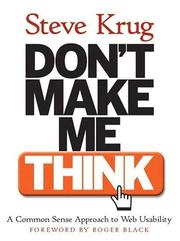Are you searching for the ultimate reading list to enhance your knowledge of UX design? Look no further! We’ve compiled a curated collection of the 20 best books on UX design that every designer should have on their radar. Whether you’re a seasoned professional or just starting out in the field, these books cover everything from user research and interaction design to usability testing and prototyping. So, grab a cup of coffee, cozy up with one of these essential reads, and prepare to level up your UX design skills!
Contents
- 1 20 Best Ux Design Books
- 2 The Design of Everyday Things
- 3 Don’t Make Me Think
- 4 Lean UX
- 5 Hooked: How to Build Habit-Forming Products
- 6 Sprint: How to Solve Big Problems and Test New Ideas in Just Five Days
- 7 Designing for Interaction
- 8 The Elements of User Experience
- 9 UX Strategy: How to Devise Innovative Digital Products that People Want
- 10 The User Experience Team of One: A Research and Design Survival Guide
- 11 Designing Interfaces: Patterns for Effective Interaction Design
- 12 UX for Lean Startups: Faster, Smarter User Experience Research and Design
- 13 The UX Book: Process and Guidelines for Ensuring a Quality User Experience
- 14 100 Things Every Designer Needs to Know About People
- 15 Designing for the Digital Age: How to Create Human-Centered Products and Services
- 16 The User’s Journey: Storymapping Products That People Love
- 17 Don’t Make Me Think, Revisited: A Common Sense Approach to Web Usability
- 18 The Design of Everyday Things
- 19 Seductive Interaction Design: Creating Playful, Fun, and Effective User Experiences
- 20 The Elements of User Experience: User-Centered Design for the Web and Beyond
- 21 Designing for Interaction: Creating Innovative Applications and Devices
- 22 Final Thoughts on Best Ux Design Books
- 23
20 Best Ux Design Books
The Design of Everyday Things
by Don Norman
The Design of Everyday Things, written by Don Norman, is a renowned book on UX design that explores the principles of user-centered design. In this insightful and engaging book about UX design, Norman delves into the psychology behind how people interact with everyday objects and how design can make these interactions more intuitive and user-friendly. He discusses the concept of “affordances,” which are the perceived actions that an object or system offers to its users, and how designers can use this concept to create more effective and user-friendly products. Norman also emphasizes the importance of understanding the cognitive processes and behaviors of users in order to create designs that are intuitive and easy to use. With real-world examples and practical insights, this UX design book is a valuable resource for designers, product developers, and anyone interested in understanding the thought process behind effective and user-friendly design.
Don’t Make Me Think
by Steve Krug
Don’t Make Me Think by Steve Krug is a widely acclaimed book on user experience design. Krug’s straightforward and humorous writing style makes this book about UX design an engaging and informative read for both beginners and seasoned professionals. With a focus on web usability, the book provides practical advice and best practices for creating intuitive and user-friendly interfaces. Krug’s central premise is that a good website should be self-explanatory and require minimal effort from users to navigate. He emphasizes the importance of clear visual cues, concise content, and efficient navigation to create a seamless user experience. Whether you’re a web designer, developer, or product manager, this UX design book will help you understand the fundamental principles of good design and how to apply them to your own projects. Don’t Make Me Think is an essential resource for anyone looking to improve their understanding of user experience and create more intuitive digital experiences.
Lean UX
by Jeff Gothelf and Josh Seiden
Lean UX by Jeff Gothelf and Josh Seiden is a groundbreaking book on UX design that revolutionizes the traditional approach to product development. The authors introduce the concept of Lean UX, which focuses on rapidly testing and validating ideas through continuous feedback and iteration. This approach emphasizes collaboration, iteration, and a deep understanding of the end user’s needs.
With a strong emphasis on experimentation and a user-centric mindset, this book about UX design provides invaluable insights and practical techniques for creating successful products in today’s fast-paced and competitive market. It encourages cross-functional teams to work together closely, breaking down silos and fostering a culture of continuous learning and improvement.
Whether you’re a designer, developer, product manager, or entrepreneur, Lean UX offers a fresh perspective and actionable strategies for creating user-centered, innovative products. This UX design book is a must-read for anyone looking to create impactful and successful products in a rapidly changing world.
Hooked: How to Build Habit-Forming Products
by Nir Eyal
Hooked: How to Build Habit-Forming Products by Nir Eyal is a compelling and insightful book about creating products that users can’t help but engage with. Eyal delves into the psychology of habit formation and explains how companies can use this knowledge to design products that keep users coming back for more. This book on UX design provides a practical framework for building habit-forming products, focusing on the “hook model” which consists of trigger, action, variable reward, and investment.
With real-world examples and actionable advice, Eyal shows how companies like Facebook, Twitter, and Instagram have successfully implemented these principles to create habit-forming products. Whether you’re a product designer, marketer, or entrepreneur, this book about UX design will give you valuable insights into how to create products that users love and can’t stop using. It’s a must-read for anyone looking to understand the psychology behind habit-forming products and how to apply these principles to their own work.
Sprint: How to Solve Big Problems and Test New Ideas in Just Five Days
by Jake Knapp
Sprint: How to Solve Big Problems and Test New Ideas in Just Five Days by Jake Knapp is a game-changing book on UX design that presents a revolutionary approach to solving complex business challenges. The book introduces the concept of the sprint, a five-day process for answering crucial questions through prototyping and testing ideas with customers. It is a practical guide that provides step-by-step instructions for running a sprint, along with real-world examples and insights from Jake Knapp’s experiences at Google Ventures.
This UX design book is not just for designers and product teams; it’s for anyone looking to solve big problems and test new ideas quickly and efficiently. The sprint process outlined in the book is designed to save time, reduce risk, and lead to better solutions. It’s a must-read for anyone interested in innovation, entrepreneurship, and problem-solving, as it offers a proven method for tackling challenges and driving meaningful change. Sprint is a valuable resource for anyone looking to make a significant impact in their business or organization.
Designing for Interaction
by Dan Saffer
Designing for Interaction by Dan Saffer is a comprehensive and insightful book on UX design. Saffer explores the principles and practices of designing user experiences for digital products, offering practical guidance for creating intuitive and engaging interactions. The book delves into the psychology of user behavior, the importance of understanding user needs, and the role of empathy in design. Saffer also discusses the impact of technology on user interactions and how to design for emerging trends such as mobile and responsive design. With a focus on creating meaningful and effective user experiences, this book is a valuable resource for designers, developers, and anyone interested in creating user-centered digital products. Whether you’re a seasoned professional or just starting out in the field, Designing for Interaction provides valuable insights and actionable strategies for creating compelling user experiences.
The Elements of User Experience
by Jesse James Garrett
The Elements of User Experience by Jesse James Garrett is a seminal book about UX design. It offers a comprehensive and insightful overview of the various aspects that contribute to creating a user-centered digital product. Garrett breaks down the complex process of UX design into five distinct elements, providing a clear and structured framework for understanding and implementing user experience principles.
Through engaging and practical examples, the book provides a deep understanding of how to approach and address the needs and expectations of users. It covers everything from user research and information architecture to interaction design and visual design, making it an essential resource for anyone involved in creating digital experiences.
Whether you’re a seasoned UX professional or just starting out in the field, The Elements of User Experience offers valuable insights and practical guidance that can help you create products that truly resonate with your audience.
UX Strategy: How to Devise Innovative Digital Products that People Want
by Jaime Levy
UX Strategy: How to Devise Innovative Digital Products that People Want by Jaime Levy is a must-read for anyone interested in creating successful digital products. This groundbreaking book on UX design provides a comprehensive guide to developing a strategic plan that aligns with users’ needs and business goals. Levy, a seasoned UX strategist, shares her insights and expertise, offering practical advice on how to research, define, and implement a winning UX strategy.
The book about UX design outlines a step-by-step approach to crafting digital products that not only meet users’ needs but also drive business growth. Levy’s innovative methodologies and real-world examples make this UX design book a valuable resource for entrepreneurs, product managers, and designers looking to create impactful digital experiences. Whether you’re a seasoned professional or a newcomer to the field, UX Strategy will inspire you to rethink your approach and devise innovative digital products that people want.
The User Experience Team of One: A Research and Design Survival Guide
by Leah Buley
The User Experience Team of One: A Research and Design Survival Guide by Leah Buley is a comprehensive book on UX design that is perfect for solo practitioners and small teams. Buley provides valuable insights and practical advice for individuals who find themselves as the sole UX design professional within their organization.
Throughout the book, Buley covers a wide range of topics essential for UX design professionals, including user research, interaction design, information architecture, and usability testing. She also offers guidance on how to effectively communicate and collaborate with stakeholders and team members to drive successful UX design outcomes.
Buley’s writing style is engaging and accessible, making it easy for both beginners and experienced UX design professionals to grasp the concepts and apply them in their work. The book is filled with real-world examples and practical exercises that readers can use to enhance their UX design skills and make an impact within their organizations.
Designing Interfaces: Patterns for Effective Interaction Design
by Jenifer Tidwell
Designing Interfaces: Patterns for Effective Interaction Design by Jenifer Tidwell is a comprehensive book on UX design that delves into the essential patterns and principles for creating effective and user-friendly interfaces. Tidwell provides a wealth of knowledge and practical guidance for designers, developers, and anyone involved in creating digital products.
The book explores various UX design patterns and offers insightful examples and case studies to illustrate their application in real-world scenarios. Tidwell covers a wide range of topics including navigation, forms, controls, and data visualization, providing readers with a deep understanding of how to design interfaces that are intuitive, engaging, and efficient.
Whether you’re a seasoned professional or just starting out in the field of interaction design, this book is a valuable resource that will help you enhance your skills and create exceptional user experiences. With its practical approach and comprehensive coverage, Designing Interfaces is a must-read for anyone passionate about creating effective and user-centric digital products.
UX for Lean Startups: Faster, Smarter User Experience Research and Design
by Laura Klein
Are you a startup founder looking to create a user experience that will set your product apart from the competition? Look no further than Laura Klein’s book on UX design, “UX for Lean Startups: Faster, Smarter User Experience Research and Design.” Klein provides practical advice and actionable strategies for integrating user experience design into the lean startup process.
Whether you’re a product manager, designer, or entrepreneur, this book about UX design will help you understand the importance of user research, prototyping, and testing in creating a successful product. Klein emphasizes the need for a user-centered approach to design, showing how it can lead to faster iterations and smarter product decisions.
With real-world examples and case studies, “UX for Lean Startups” is a valuable resource for anyone looking to improve their product’s user experience. Klein’s straightforward writing style and expert insights make this UX design book a must-read for anyone looking to create a product that users will love.
The UX Book: Process and Guidelines for Ensuring a Quality User Experience
by Rex Hartson and Pardha Pyla
The UX Book: Process and Guidelines for Ensuring a Quality User Experience is a comprehensive guide for anyone interested in improving the user experience of digital products. Written by Rex Hartson and Pardha Pyla, this book on UX design covers a wide range of topics, from understanding user needs and behaviors to designing and evaluating user interfaces.
With its practical and hands-on approach, the book provides a step-by-step process for creating user-centered designs and offers guidelines for conducting usability testing and gathering user feedback. The authors emphasize the importance of collaboration and communication in the UX design process, making it a valuable resource for designers, developers, and product managers.
Whether you’re new to UX design or looking to enhance your skills, this book about UX design provides a solid foundation and practical insights for creating products that truly resonate with users. With its clear and accessible writing style, The UX Book is a must-read for anyone passionate about delivering exceptional user experiences.
100 Things Every Designer Needs to Know About People
by Susan Weinschenk
Are you a designer looking to understand the psychology behind user experience? Look no further than Susan Weinschenk’s book on UX design, “100 Things Every Designer Needs to Know About People.” In this insightful read, Weinschenk delves into the intricate relationship between human behavior and design, offering 100 valuable insights that will help you create more intuitive and engaging user experiences.
From the impact of color and typography to the psychology of decision-making and motivation, this book about UX design covers a wide range of topics essential for any designer. Weinschenk’s practical and easy-to-understand approach makes this book a valuable resource for both beginners and seasoned professionals in the field of UX design.
Whether you’re designing websites, apps, or other digital products, “100 Things Every Designer Needs to Know About People” will provide you with the knowledge and tools to create designs that truly resonate with your audience. So, if you’re ready to take your UX design skills to the next level, this is a must-read UX design book for your collection.
Designing for the Digital Age: How to Create Human-Centered Products and Services
by Kim Goodwin
Designing for the Digital Age by Kim Goodwin is a comprehensive book on UX design that delves into the principles and techniques of creating human-centered products and services. Goodwin, a renowned expert in the field, provides valuable insights and practical guidance for designers, product managers, and anyone involved in the creation of digital experiences.
The book covers a wide range of topics, from understanding user needs and behavior to the process of designing and testing prototypes. Goodwin emphasizes the importance of empathy and collaboration in ux design, and offers strategies for integrating user research into the design process.
With real-world examples and case studies, Designing for the Digital Age offers a wealth of knowledge that is both informative and engaging. Whether you’re a seasoned professional or just starting out in the field, this ux design book is an invaluable resource for creating products and services that truly resonate with users.
The User’s Journey: Storymapping Products That People Love
by Donna Lichaw
The User’s Journey: Storymapping Products That People Love is a captivating book on UX design that takes readers on a journey of understanding user experience through the art of storytelling. In this insightful book about UX design, Donna Lichaw demonstrates how to create compelling user experiences by applying the principles of storytelling to product design. Lichaw introduces the concept of storymapping, a powerful tool that helps designers and product managers visualize the user’s journey and identify key touchpoints that shape the user experience.
By drawing parallels between storytelling and UX design, Lichaw provides practical guidance on how to craft meaningful and engaging user experiences that resonate with people. Through real-world examples and case studies, she illustrates how storymapping can be used to align cross-functional teams, prioritize features, and ultimately create products that users love. The User’s Journey is a must-read for anyone looking to deepen their understanding of UX design and learn how to create impactful user experiences through the power of storytelling.
Don’t Make Me Think, Revisited: A Common Sense Approach to Web Usability
by Steve Krug
Don’t Make Me Think, Revisited: A Common Sense Approach to Web Usability by Steve Krug is a must-read for anyone interested in user experience design. This book on UX design provides a practical and user-friendly guide to creating intuitive and easy-to-use websites. Krug’s writing style is engaging and humorous, making it an enjoyable and insightful read for both beginners and seasoned professionals in the field of user experience.
Krug emphasizes the importance of designing websites that don’t require users to think too much, hence the title. He offers practical advice and real-world examples to help readers understand the principles of good usability and how to apply them to their own projects. Whether you’re a web designer, developer, or product manager, this book about UX design will help you gain a deeper understanding of how to create websites that are intuitive, efficient, and user-friendly. Don’t Make Me Think, Revisited is an essential addition to any UX designer’s library.
The Design of Everyday Things
by Donald A. Norman
The Design of Everyday Things by Donald A. Norman is a classic book on UX design that explores the psychology behind the everyday objects we interact with. Norman delves into the principles of good design, explaining how well-designed products can make our lives easier and more enjoyable. He also highlights the importance of understanding human behavior and cognitive processes when creating user-friendly experiences. This book about UX design is filled with real-world examples and case studies that demonstrate the impact of good and bad design on our daily lives. Norman’s engaging writing style and insightful observations make this UX design book a must-read for anyone interested in understanding the thought processes and behaviors that drive our interactions with the world around us. Whether you’re a designer, engineer, or simply someone who appreciates good design, The Design of Everyday Things offers valuable insights into the art and science of creating user-friendly experiences.
Seductive Interaction Design: Creating Playful, Fun, and Effective User Experiences
by Stephen Anderson
Seductive Interaction Design: Creating Playful, Fun, and Effective User Experiences by Stephen Anderson is a captivating book on UX design that explores the art of crafting irresistible digital experiences. Anderson’s engaging writing style and insightful examples make this book about UX design a must-read for designers and anyone involved in creating user interfaces.
Through a combination of psychology, design principles, and real-world case studies, Anderson demonstrates how to create interfaces that not only meet users’ needs but also captivate and delight them. He delves into the concept of “seductive interactions,” which are experiences that draw users in and keep them engaged.
This UX design book is not just about aesthetics; it’s about understanding human behavior and leveraging that knowledge to build compelling digital products. Whether you’re a seasoned designer or just starting in the field, Seductive Interaction Design offers valuable insights and practical techniques for creating experiences that users will love.
The Elements of User Experience: User-Centered Design for the Web and Beyond
by Jesse James Garrett
The Elements of User Experience: User-Centered Design for the Web and Beyond by Jesse James Garrett is a comprehensive guide to the principles and practices of creating effective user experiences. This influential book on UX design provides a clear and practical framework for understanding and implementing user-centered design. Garrett breaks down the process into five essential elements, from strategy and scope to the surface layer of the design. By exploring the interplay between these elements, readers gain a deeper understanding of how to create user-friendly and engaging digital experiences.
Whether you’re a seasoned professional or just starting out, this book about UX design offers valuable insights and actionable strategies for anyone involved in creating digital products. With its accessible language and real-world examples, The Elements of User Experience is an indispensable resource for designers, developers, and anyone else interested in creating user-centered digital experiences. If you want to enhance your understanding of UX design and create more impactful digital products, this is the book for you.
Designing for Interaction: Creating Innovative Applications and Devices
by Dan Saffer
Designing for Interaction: Creating Innovative Applications and Devices by Dan Saffer is a comprehensive book on UX design that provides valuable insights into the world of designing interactive experiences. Saffer explores the principles and practices of creating user-friendly interfaces for digital products and devices, emphasizing the importance of user research, prototyping, and iteration in the design process. The book covers a wide range of topics, including information architecture, interaction design, and usability testing, making it an essential resource for anyone interested in creating compelling user experiences.
Saffer’s writing style is clear and engaging, making complex concepts easily understandable for both beginners and seasoned professionals in the field of UX design. With real-world examples and case studies, Designing for Interaction offers practical guidance on how to design innovative and intuitive applications and devices that meet the needs of users. Whether you’re a designer, developer, or product manager, this ux design book provides valuable insights that can help you create impactful digital experiences.
Final Thoughts on Best Ux Design Books
In conclusion, these 20 best books about Ux Design offer valuable insights and practical guidance for professionals and enthusiasts in the field. Whether you’re a seasoned designer or just starting out, these books provide a wealth of knowledge to help you hone your skills and stay ahead of the curve in the ever-evolving world of UX design.
Which book about Ux Design is best?
The best book on Ux Design can vary with personal preference, but three widely recommended titles are:
- The Design of Everyday Things by Don Norman,
- Don’t Make Me Think by Steve Krug,
- Lean UX by Jeff Gothelf and Josh Seiden.
Each offers valuable insights and could be a great starting point.
What are the best books to learn about Ux Design?
For those looking to learn about Ux Design, there is a wealth of literature that can provide a comprehensive understanding of the subject. Some of the most highly recommended books include:
- The Design of Everyday Things by Don Norman,
- Don’t Make Me Think by Steve Krug,
- Lean UX by Jeff Gothelf and Josh Seiden,
- Hooked: How to Build Habit-Forming Products by Nir Eyal,
- Sprint: How to Solve Big Problems and Test New Ideas in Just Five Days by Jake Knapp,
- Designing for Interaction by Dan Saffer,
- The Elements of User Experience by Jesse James Garrett,
- UX Strategy: How to Devise Innovative Digital Products that People Want by Jaime Levy,
- The User Experience Team of One: A Research and Design Survival Guide by Leah Buley,
- Designing Interfaces: Patterns for Effective Interaction Design by Jenifer Tidwell
These books offer a range of perspectives on Ux Design, covering various aspects and approaches to the subject.
What are the best books about Ux Design?
The best books about Ux Design are:
- The Design of Everyday Things by Don Norman,
- Don’t Make Me Think by Steve Krug,
- UX for Lean Startups: Faster, Smarter User Experience Research and Design by Laura Klein,
- The UX Book: Process and Guidelines for Ensuring a Quality User Experience by Rex Hartson and Pardha Pyla,
- UX Strategy: How to Devise Innovative Digital Products that People Want by Jaime Levy,
- Designing for Interaction by Dan Saffer.
Each offers unique insights into the subject. While these books about Ux Design are highly regarded, it’s important to note that any list of ‘best’ books is subjective and reflects a range of opinions.
What are the best Ux Design books of all time?
Choosing the best Ux Design books of all time can vary depending on who you ask, but five titles that are often celebrated include
- The Design of Everyday Things by Don Norman,
- Don’t Make Me Think by Steve Krug,
- Sprint: How to Solve Big Problems and Test New Ideas in Just Five Days by Jake Knapp,
- UX Strategy: How to Devise Innovative Digital Products that People Want by Jaime Levy,
- and UX for Lean Startups: Faster, Smarter User Experience Research and Design by Laura Klein.
Each of these books has made a significant impact in the field of Ux Design and continues to be influential today.






















